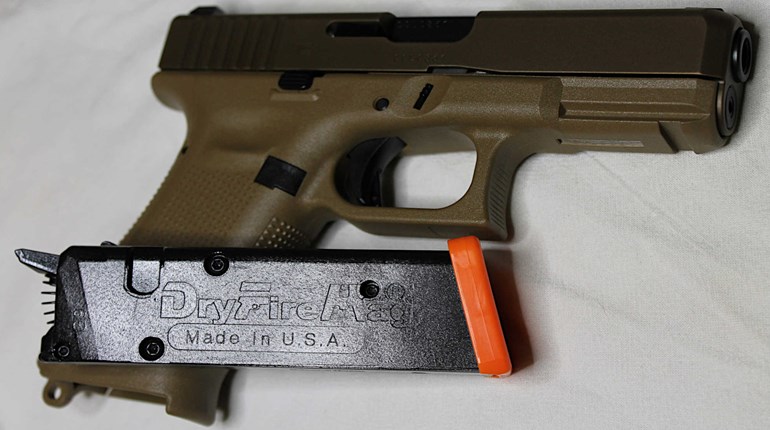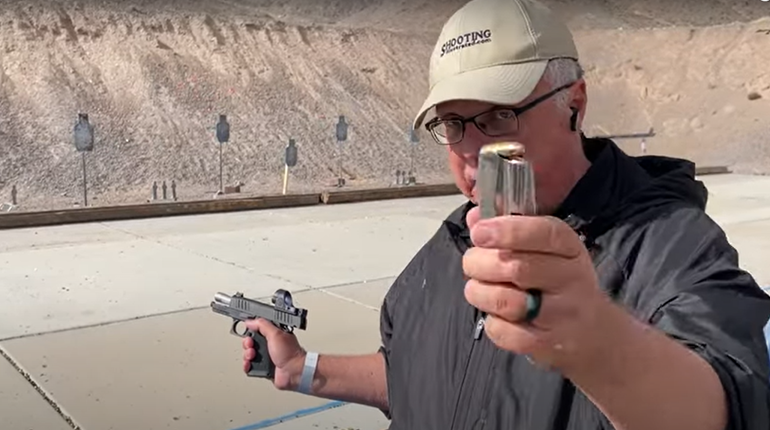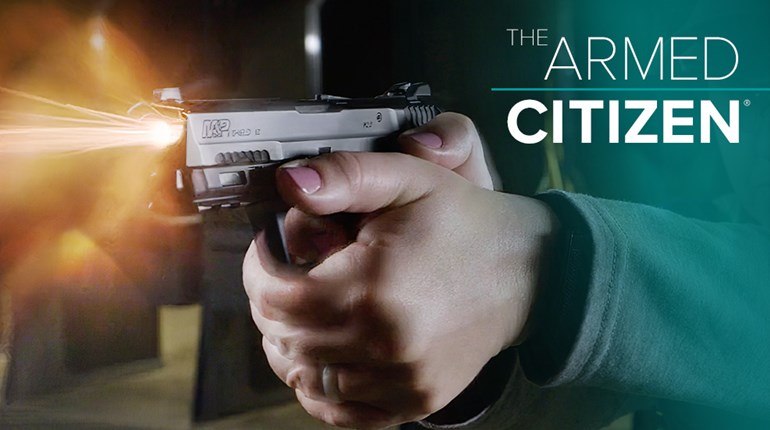
A couple weeks ago, we took a look at a “usual suspect” in semi-automatic pistol malfunctions—magazines. In modern self-loaders from a host of manufacturers, these are thankfully rare, and you can make them rarer still with good ammo and sound grip mechanics. With luck, we only encounter them on the range, but no sensible Carry Lifer should be counting on that. 100-percent reliable defensive/protective gear gives you more options, not fewer, and magazines are a major part of that “100 percent” calculus.
You can sharpen the odds in your favor by starting with good mags and maintaining them carefully. Some of the maintenance issues we’ve covered in Part I: Keep those pricey jewels free of internal and external gunk, watch the crucial springs for hints of ensuing failure, and keep followers and base plates/pads (internal and external) in working order.
The “starting with good mags” business is actually trickier than it might seem. While most manufacturers—for completely obvious reasons—don’t intentionally send poor magazines with a firearm, it doesn’t follow that those mags are the best available for a given firearm and caliber. Stopping short of the actual stink-eye for several manufacturers who make otherwise fabulous pistols, we’ll issue a more general warning, and 1911 shooters in particular should beware. Your factory mags will likely be good with 230 FMJs in .45 ACP or 115 “ball” in 9 mm, but everything else may prove to be a crap shoot, especially defensive/carry ammunition. (Hands-down, best ever in .45 ACP? Here, the $34 stainless steel variant, though either of these are close—here (slightly better, and a remarkable value), or these that are easier to dis/reassemble. 10mm/.40 here, and 9 mm here.)
In other cases—the big-name striker ignition pistols, for instance—we stick with manufacturers’ offerings. With one notable exception, their magazines are a bit of a beating bucks-wise, but waaaaaaaay better than aftermarket/budget options. Just, er, bite the bullet.
That exception, however, deserves a shout-out—Glock. The company’s magazines are famously tough and reliable (we have several 20-year-old samples still running fine), and can even be found on sale now and again. Bought at MSRP, they’re still 25 to 50 percent less expensive than most competitors. In a slightly perverse free market twist, a very sound, viable alternative is available where it’s arguably least needed, thanks to Magpul.
There’s a tidbit of good news here: Our research indicates this might finally be changing for the better (Springfield XD(M), for instance, here). Manufacturers are perhaps deciding they’d rather sell you their good mags less expensively than have you assert problems with their products while using generally inferior substitutes. That’s a good call in our view, and it’s about time, too. Maybe some aftermarket providers will now up their game as well.
But let’s assume you’ve done your due diligence and have uniformly good mags in your carry kit, and that you’re keeping the first four maintenance tasks under control. The fifth consideration on your radar is a big one—the condition of what are called “feed lips.” These are the carefully formed tops of the magazine body that guide cartridges into firing position in the chamber of your pistol with each successive cycling of the slide.
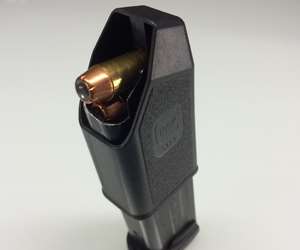
It’s easy to appreciate that these are in no way trivial: Without correct and preserved geometry here, you’ve got a single shot, and a slow, finicky one at that. Worse, there’s very little you can do to “fix” them once they’re out of whack. Without going into complex metallurgy, this is what you’re really paying for when you plop down between $20 and $50 per mag—the appropriate metal, formed in what we hope is a permanent, durable way. As a result, “maintaining” the feed lips doesn’t happen like the other factors we’ve discussed. Instead, our goal is to preserve them.
Once again, and in no particular order, here are some suggestions:
Learn a method for loading your magazines that you can apply easily. Wrestling with your mags is one of the best ways we know to slowly but surely work those carefully formed lips out of tolerance and eventually create malfunctions. For many, particularly for women (sorry, ladies, we concur that the hand-strength issue is a rotten, gender-linked inequality, and we’d fix it if it were within our power), this means using a “loader” of some type. Some firearms include them—Glocks, for instance—and others are available for very reasonable cost (roughly four pages of them here, at Brownells).
Don’t get it in your head that they need to be complex or expensive to work, either. We’ve used the no-moving-parts “sleeve” style that has come with every Glock for decades, and on many more magazines than that marque. The point is, try them more than once to figure out the one you like and which works best. Buy it if you must, and use it.
The benefit to these are uniform: As you load, you won’t lose control of rounds in such a way that damages the feed lips by applying asymmetric pressure either front-to-back or side-to-side (even minor but repeated misalignments can cause deformation over time). By loading rounds on the exact, reverse path of the way the magazine was designed to guide and release them in the feeding process, you’ll maximize life and minimize wear.
Learn a proper reload, and practice it to exclusion. Don’t roll your auto-loader down toward the waist and peer into it as you unload/reload. If you do, you’ll almost certainly need to pull the magazine from the pistol. Several bad things happen here, though only one risks direct harm to the magazine.
For starters, it’s abominably slow—keep the pistol high as you reload, “in your workspace” is common parlance. A very slight twist of the wrist is all that’s needed to see the magwell and reload then, and this lets gravity do its work to pull the expended mag from the pistol. On a tactical reload where the magazine is retained, such lowering/rolling is merely turtle-ish, but it’s on the speed reload that mag damage can occur. If you draw the mag out by the base and discard it from a low position, the net effect of the motion is throwing that magazine at the ground with the feed lips down. One or both feed lips (especially in single stack mags) can be damaged by this, especially if the mag is empty. One drop won’t likely matter, but especially on hard or indoor surfaces, a few dozen can misshape the feed lips enough to wreck the magazine.
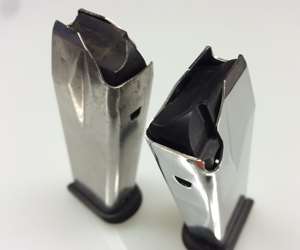
Some folks worry about the longer fall from the high position, but this is unlikely to damage a quality magazine. It will be falling on the base in such a case, where materials like polymer can do their shock-absorbing best. If your mags lack polymer bases or don’t have some sort of bumper, this is a problem. Get some.
When practicing reloads, have action-proving or other dummies in the magazine. Don’t routinely load empty magazines into your pistol at all, particularly not at the speed that reloading practice implies (pretty fast, we hope). Even slight misses mean the now-unsupported feed lips will collide with potentially damaging surfaces without a round buttressing them from below. Think it through: This is what occurs with live fire reloads, and does protect the lips from underneath.
This is far less of a problem with polymer-framed firearms, but a biggish deal with metal-on-metal rigs (e.g. 1911s). We recommend two such faux rounds, as that’s sufficient to “level” followers completely, thereby supporting the feed lips along their full length. More than two actually has disadvantages. First, it may add enough weight—especially in .40 or .45—to disguise drop-free issues. It also puts unnecessary mass in the magazine for its fall to earth. Good pads, of course, negate this, but we like to save all the life we can for actual use. An old pillow under ours during practice makes the landing as gentle as possible.
Remember to do this, like all dry fire, with absolutely no live ammo anywhere nearby. (Find dummy rounds here.)
Unload your magazines properly. Almost no drill, training, competitive or even combat regimen will result in every magazine being emptied of every round, every time. Yet if you watch people unload magazines as we do when this necessity ensues, a little thought will likely have you mimicking our cringes. Especially in rifle magazines—or in very new mags of almost any type with springs not yet worn in—you’ll see folks literally torque at least the first two rounds up and out of the mags.
We know of few more reliable ways to “mysteriously” shorten magazine life. But just in case it isn’t clear, here’s the problem: Upward leverage is being isolated and strongly applied through the cartridge case to the carefully formed, crucial forward edges of the feed lips. While the steel of the lip itself is much harder than the brass of the case and can resist literal material-on-material wear almost indefinitely, the geometry of the lip will not. For this precise reason—as well as spring wear—magazines should also not be left loaded for long periods. (As we discussed here, rotate mags from “ready” to “rest” status.) Except for the few milliseconds that stripping the new round forward and up into the chamber requires, the up-force necessary for loading is meant to be applied along the entire length of the feed lip, or not at all.
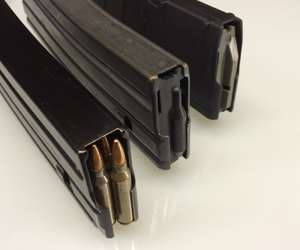
How to do this? Certainly don’t cycle them, and don’t try to bully them forward (especially not with a tool … can you say “external firing pin”? It’s not as dangerous as some would have you imagine, but alarming at the very least). Instead, press gently down on the top round to relieve the tension of the mag spring pressing the cartridge (or cartridges) up against the feed lips, and then push the top round directly forward. Lather, rinse, repeat. This will be very easy if there are only a few rounds in your mag, but tougher if you must un-tension a fully loaded mag.
Note that some mags—and especially those in semi-automatic rifles—quite often do not have sufficient relief in the front mag wall to readily allow this: The case mouth of the cartridge will catch (very early SIG P320 mags sometimes did this, and many 9 mm single-stack mags still do). Talk with your gunsmith, of course, but we recommend very slight relief of the magazine here to permit smooth unloading. This is not mere convenience. Slight, undetected flaring of, or other damage to, the cartridge neck can occur without this larger opening. We’ve seen it stiffen subsequent rechambering in a rifle, though never prevent it. Pistols, however, are a different and worrisome matter. Lacking the longer, more energetic charging stroke of the rifle, a pistol case mouth can be buggered up enough to prevent rechambering. That’s a serious potential problem in a defensive situation.
Even if you’ve never had a lick of trouble with your mags—which we sincerely hope is the case—we end with a reminder carried over from Part I. Central to good magazine maintenance is the ability to differentiate them from one another. If your good luck continues and routine maintenance keeps them all running, you’ve lost nothing. But know that this is nigh unto miracle: If you’re really training enough for a prepared Carry Life, one of your magazines will eventually need unanticipated attention. Then, whether it’s a metallic-ink Sharpie (actually great for polymer-sheathed mags or bases), or the likes of these, the ability to tell the offender from its brethren may prove to be a literally lifesaving advantage.
So mind those magazines, and Carry on.











